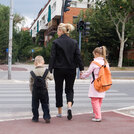
Neighborhood design, namely walkability, may contribute to significantly more overall physical activity of residents. In walkable neighborhoods, the increase in walking for errands amounted to 70 more minutes of moderate to vigorous physical activity per week. There was no significant difference for self-elected exercise and walks for leisure between residents in neighborhoods with low walkability and those in neighborhoods with high walkability.
Saelens, Brian E., James F. Sallis, Jennifer B. Black, and Diana Chen. (2003) Neighborhood-based differences in physical activity: An environment scale evaluation. American Journal of Public Health 93(9), 1552-1559.
